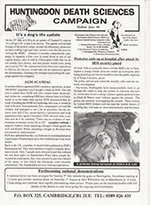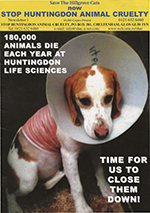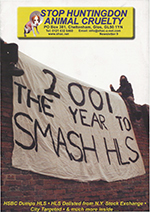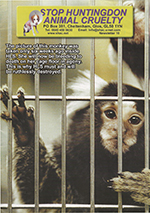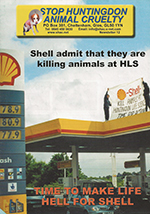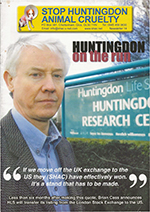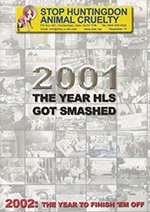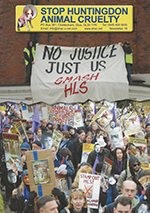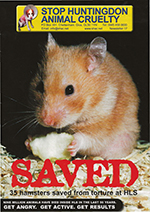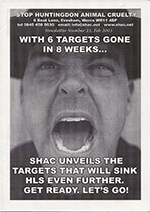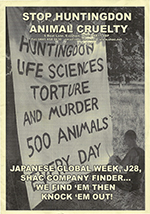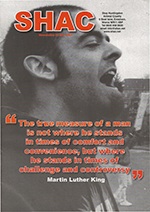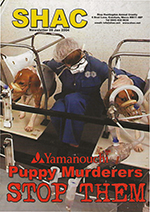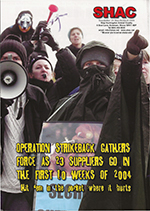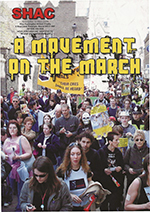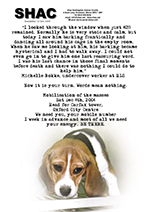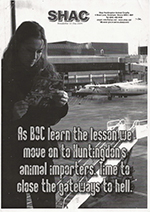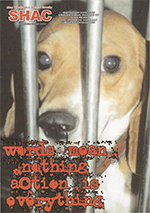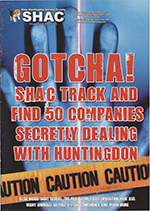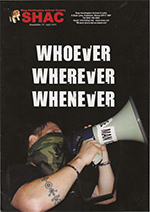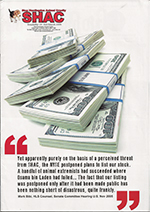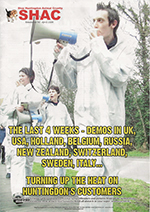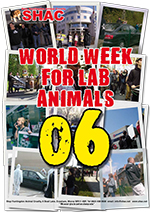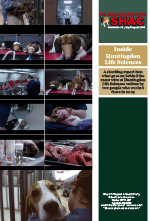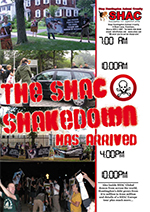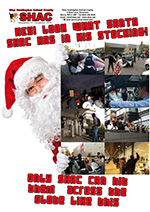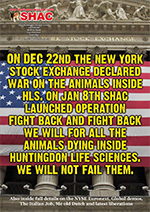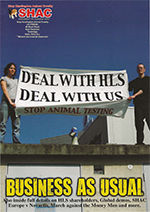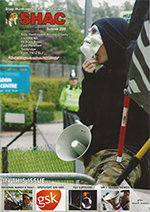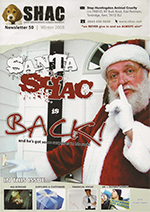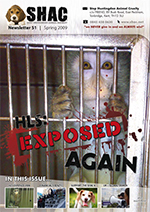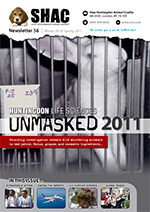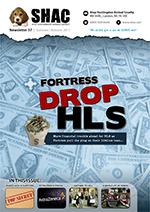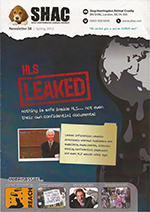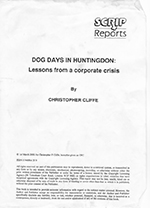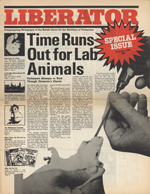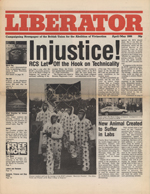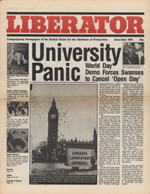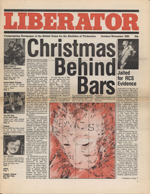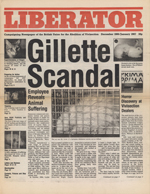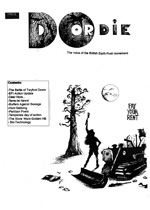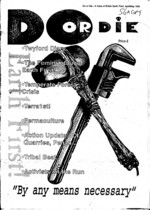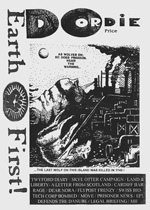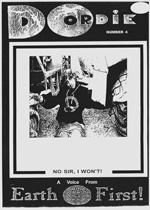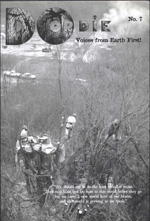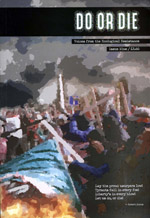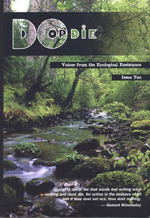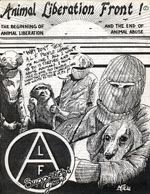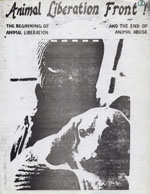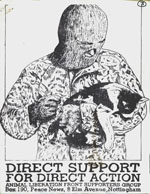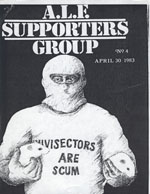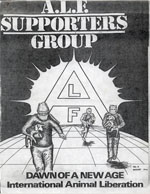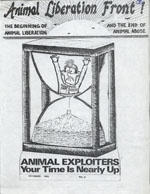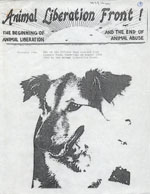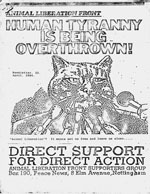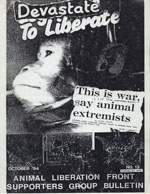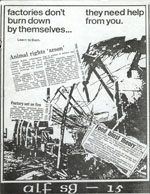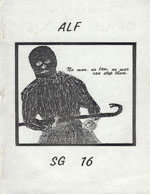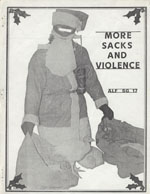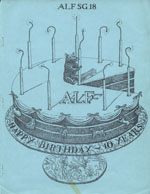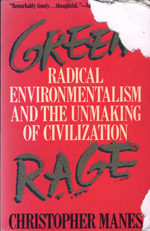Category
Most Popular
-
Campaign newsletters, Most Popular, Periodicals
History as it was made: A trove of anti-Huntingdon Life Sciences newsletters.
Huntingdon Death Sciences Newsletter, three various issues. Stop Huntingdon Animal Cruelty (UK) Newsletters 1-20, 22-23, 25-58. Dog Days in Huntingdon. (1998-2011, Various Locations, England)
Since the release of The Animal People documentary there has been a renewed interest in the legacy of Stop Huntingdon Animal Cruelty. Unfortunately the film’s focus on the trial of the SHAC 7 in the United States has left many people with no knowledge of the international campaign. Luckily Tom Harris, a former SHAC prisoner from England, is righting that wrong with a new written history of the various campaigns against HLS. He has taken the effort to scan a number of newsletters during his reaserch and has kindly shared the documents with TALON for our first major post in five years. We have also included Dog Days in Huntingdon, an insiders account of working at Huntingdon in the late 90s and early 2000s. Special thanks to Aaron Zellhoefer for the scan.
…
-
BUAV Liberator, Most Popular
BUAV Liberator 1986
BUAV Liberator (1986. London, England)
“Although the BUAV as a limited company can only organize legal activity, we aim to complement and support direct action whenever possible.” BUAV editorial, April-May 1986
Frequent readers of the site will be aware that TALON’s volunteers are big fans of the BUAV Liberator. Not only do its old pulp pages bleed with animal lib history, but the politics represented by BUAV at that time were among the most progressive (and occasionally radical) of any major national non-profit working for non-humans.
During this era the British Union to Abolish Vivisection supported any direct action which did not include pre-meditated violence towards a human, and proudly advocated a broad array of strategies and tactics. From letter writing to sabotage, legislation to arson, the BUAV gave coverage to nearly all of the activism in England at the time- and that is only a small part of what makes these papers so great.
Year after year, each volume of the Liberator gives us clues as to the mood within the movement. In 1986 for example, we see a somber tone set over the movement as the Liberation League’s began to fold, the government passed legislation expanding vivisection, and dozens of activists began prison sentences over lab raids. This blow to activist morale in 1986 was perhaps most visible in the actions of Robert Blackman, a young man who entered the Colchester cattle market and self immolated to protest the sell of living beings. His mother later said that “He gave his life because he thought the cruelty would never stop.”
Interestingly, 1986 was also a year filled with inspiring actions for animals. Issue after issue details labs shut down, vivisectors ending their careers, a dramatic rise in veganism and vegetarianism among the general public, and non-humans having their first taste of freedom. It is only within the context of the meteoric rise of animal rights in the earlier part of the 1980s could this year be seen as any kind of a failure. Indeed, if the level of activism in these issues were to occur today morale would sky rocket and great breakthroughs could be made- and all of us should take that as a challenge!
…
-
Do or Die, Most Popular, Periodicals
Do or Die – The Complete Set!
Do Or Die #1-10 (1993-2003, Brighton, England.)
A few years ago a friend asked me if I had a complete set of Do or Die, the British Earth First! publication that inspired and incited eco-warriors throughout the 1990s and early 2000s. At one time I did have them, but they had long since been stolen by a Joint Terrorism Task Force.
After a brief discussion, we decided that Do or Die was too important to fade into obscurity. We began tracking down each issue, and decided that while we were at it we ought to archive some other publications as well. That effort is how this web site began, and now, thanks to 56a infoshop of South London and Tim @ NEDS Northampton, we can finally share the very rare issue #2. This completes our collection, and our original mission as well.
When read as a set, Do or Die is a chronicle of people from across the globe counter-striking capitalism, ecocide, and the state. Each issue is better than the last, but more importantly, each page is a spark licking at the fuse of the bomb that is your heart. Once lit, you’ll know that these pages are not mere history, but a reminder that we can explode onto the world stage like the fighters before us have. Do or die, now is the time to rise.
…
-
Do or Die, Most Popular, Periodicals
Do or Die #10
Do Or Die #10 (2003, Brighton, England.)
It’s hard to believe that it has been a decade since the Do or Die collective published the final issue of their influential, book sized periodical. This last dispatch screamed the same urgent message as its predecessors: Take action now, or die alongside the rest of humanity in the coming ecological meltdown.
In the ten years since our situation has only become more desperate, and therefore the inciting cries for resistance in the pages of Do or Die have only increased in relevance. Plenty has been written on this site about this publication: that it was our reason for starting TALON, that it was the best environmental publication ever, and so on. None of that will matter if DoD’s message is ignored. Read these pages with an eye towards how you will utilize the lessons contained inside. Then, start making plans to create a better world, and implement those plans quickly, because as the title suggests, if you don’t “Do” than our species has only one other option…
The other issues of Do or Die in our archive can be found HERE.
…
-
Most Popular, No Compromise, Periodicals
No Compromise: The Final Two Issues
No Compromise #29-30 (2006. Santa Cruz / San Francisco, CA)
The early days of my activism were so exciting. After a lifetime of feeling powerless I suddenly discovered that there was a community dedicated to fighting the good fight. Its members were in every major city and many smaller ones, and sometimes not living in any city at all, but in trees and encampments. The people involved were empowered to act for themselves in order to create a better world, and had abandoned all the false hope of political parties and their dead politics. Words meant little, action was what counted, and the sky was the limit. The internet was not yet in wide use, and thank goodness! That meant that we met each other in conference rooms, in squats, on the streets, and sometimes on the pages of No Compromise magazine.
No Compromise shaped who I am today. Each new issue contained articles that helped me and thousands of others to evolve our own style of resistance, and as our experience grew we were able to share our stories in the pages of the magazine.
After 30 issues, the steering committee of No Compromise decided to stop publishing in 2006. Their decision could not have come at a worse time. With the SHAC website and newsletter killed by the convictions of the SHAC 7, Bite Back being published only sporadically and with a limited focus, and the Earth First! Journal mired in its “Confronting Oppression Within” drama, the sudden absence of No Compromise meant that the primary sources for radical animal liberation news, opinion, and strategy were the twin sewers of online social networks and the North American Animal Liberation Press Office. These were dark times for our movement, and we are only just beginning to recover.
The final issues of No Compromise were the best of the series, though! I was in prison when issue 30 was released, and it felt electric in my hands. I read it over and over, alternately laughing and crying. As I was putting this post together I decided to pull out that print copy. It gave me the same sense of awe I had when I read those first issues. More than that, it reminded me that there is still a community of people capable of changing the world through compassionate direct action and mutual aid. And you know what? We are going to win!
KEEP FIGHTING,
Josh Harper(The complete set of all past issues of No Compromise can be found HERE)
…
-
Most Popular, Periodicals, The SG (original 80s volume)
The ALF Supporters Group Newsletter – The complete original set!
The ALF Supporters Group Newsletter #1-19 (1982-1986. Nottingham / London, England)
When this archive project was founded two years ago, a list was made of the ten publications that we “had to have.” Number one was a complete set of the first volume of “The SG.” This was a tall order, and we knew it. First off, the Animal Liberation Front Supporters Group must be one of the most raided entities in England, and its members were frequently raided themselves! The result was that many copies of the magazine ended up in police custody both before and after distribution, never to be seen again. Second, it was a relatively old newsletter, and since the first issues were mimeographed on cheap paper, finding intact copies was going to be difficult. We persevered though, and now these rare pieces of movement history are preserved digitally and online for everyone to read and learn from.
Started by Dave Nicholls in 1982, the ALF Supporters Group was an effort to do two things: 1.) To raise funds for people arrested for animal related direct actions. 2.) To create a broader base of support for the Animal Liberation Front inside the movement. Both goals were met quickly. Within two weeks of their founding, the Supporters Group hit the number of members they had set as their long term goal. Through direct donations, memberships, fundraising events, and sales of merchandise, the SG was able to contribute towards the sizable legal costs of activists being arrested across England.
The newsletter itself went through varying degrees of quality in writing, layout, and value to the movement. The early days of the Nicholls run may have had a drab interior, but the hand illustrated covers were sometimes gorgeous, and the rhetoric had not yet strayed into the more-militant-than-thou nonsense which came later. Eventually the writing would border on the cultish, but there is scarcely an issue of the magazine that doesn’t have some redeeming value. When read critically and as a whole body of work, this magazine follows the rise and spread of underground action for animals across the globe, illustrates the value of coalition building, and provides solid examples of extremism to be avoided through coverage of groups like the Animal Rights Militia. It also provides many historical details found nowhere else!
“The SG” has gone through several incarnations since British Law enforcement shut this one down in 1986. (While carrying out the investigation for the notorious Sheffield trial that sent Ronnie Lee to prison for 10 years, the police raided the SG and charged it’s editors with incitement. Everything published by the SG afterwords had to be run past a lawyer first, but this didn’t stop further raids, arrests, and convictions of those involved in the newsletter.) It is still being published today, copies can be ordered from www.alfsg.org.uk.
Finally, an excellent analysis and critique of the SG and the rise of England’s “Cult of Militancy” can be found in the book Against All Odds, available here at the Talon Conspiracy.
…
-
Books, Most Popular
Green Rage
12.03.12 | Permalink | Comments Off on Green RageGreen Rage: Radical environmentalism and the unmaking of civilization (1990, Boston, MA.)
One of the first books I bought about radical wilderness defense was Green Rage. It is an excellent investigation of the origins of (western) environmental radicalism, and I recommend that you read it cover to cover.
Speaking of covers, you might notice that this particular copy of Green Rage is a little ragged. The reason for that is because this is my copy, and after reading the book I took it’s message to heart. Several years ago in Oregon, a small group of activists from around the region were protesting at a breeding facility that supplied rabbits to the vivisection industry. When we arrived the farms owners were not present, and neither were any law enforcement. Not coincidentally I quickly found myself living with some critters who liked to chew on everything in our humble home. I hope you will enjoy Green Rage as much as they did!
…
-
Campaign newsletters, Most Popular
More SHAC USA newsletters
09.22.12 | Permalink | Comments Off on More SHAC USA newslettersSHAC USA Volume 2, issues 2 and 4 (2002, Philadelphia, PA)
It is hard to describe the feeling of constant elation that I had working on the campaign against Huntingdon Life Sciences. After years of grassroots organizing it seemed that the movement was finally moving forward with speed and determination. News constantly poured in from all corners of the globe that a new target had been chosen- and eliminated. Everyone participating was energized, hopeful, and on the attack.
One of the reasons that so many people were inspired to take action against HLS was the SHAC USA newsletter. Each issue featured the groundbreaking graphic design work of Jake Conroy. His layouts and other artistry made each copy a pleasure to behold, and also left other organizations scrambling to improve the designs of their own publications. If you doubt that a periodical could prompt someone to pickup a sign, bullhorn, or brick, than you feel very different than the US Government. They were so threatened by Conroy’s print and web work that he was indicted in the SHAC 7 case, and received one of the longest sentences of all of the defendants.
These two issues of the newsletter date from 2002, which was an exciting time in the campaign. After Stephens Inc. had capitulated, thousands of people suddenly had faith that they could, in fact, change the world. We all knew that we were a part of something special, and I think that comes across in the text and imagery of of these two movement gems. Sure, we were cocky, our rhetoric sometimes went too far, and we weren’t always as organized or prepared as we claimed- but we walked our talk to the best of our ability and our efforts took the movement far.
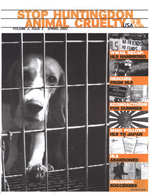
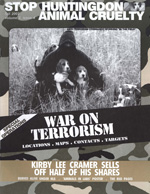
-
Earth First! Journal, Most Popular, Periodicals
Earth First! Journal 1986
09.13.12 | Permalink | Comments Off on Earth First! Journal 1986Earth First! Journal Volume 7, Issue #1-8 (Tucson, AZ.)
One of our dreams here at Conflict Gypsy has been to build a complete collection of the Earth First! Journal, the radical environmental movement’s longest running periodical. While we are still missing some key issues, we have managed to gather enough of this classic publication to begin posting them one year at a time, starting with 1986.
The eight newspaper-format volumes printed by the Journal collective in 1986 are filled with fascinating tales of our eco-warrior progenitors, including Paul Watson’s epic telling of The Raid on Reykjavic in issue two. It is tempting to spend several paragraphs discussing the contents of these yellowing tomes, but perhaps it is more important to spend these words discussing the fact that the journal is still being produced- AND IT NEEDS OUR SUPPORT!
The Earth First! Journal has been documenting environmentally motivated direct action for more than 30 years, but it struggles to pay the bills these days as fewer and fewer people read print magazines. Here at CG we believe wholeheartedly that history should be “told from below,” that the words of our comrades are more important to our understanding of past events than the musings of academics and professional historians. The Journal is still the best source for this kind of news- the written accounts of actual participants in our struggle! Please do not let it disappear like so many other publications in the last decade. Subscribe to the Earth First! Journal by clicking here!







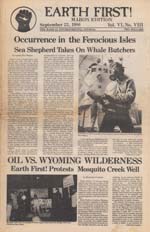
-
Books, Most Popular
The Mothercage
07.13.12 | Permalink | Comments Off on The MothercageThe Mothercage (2004, Wolverhampton, England)
“Those who carry out direct action in the cause of animal liberation are,
indeed, doing something extraordinary, but they are not super-beings, just
ordinary people who care sufficiently to risk their own liberty in bringing
freedom to other creatures. But ordinary people have their differences,
their frailties, their loves and hates and their fears…”
Ronnie Lee, from the introduction.Maire ni Bhradaig’s The Mothercage is a fictional portrayal of an Animal Liberation Front raid. Originally published in England, it was never widely available outside of Europe. Although it is written for young adults, the characters are complex enough to hold the interest of older readers. The author’s knowledge of militant AR culture makes the story a realistic representation of how activists might interact, and unlike Rage and Reason and Animal Rites, there are no former green berets running around with machine guns.
The strength of this book is Bhradaig’s willingness to present the people behind the mask as plainly, painfully human. Outside of Paul Chadwick’s Concrete: Think Like A Mountain you will not find a more accurate portrayal of a group of radicals. While some of the book’s cast are wonderful people, others are bigots, adventurists, or cowards hiding their flaws behind a balaclava.
The grassroots animal and wilderness liberation movements indulge in far too much hero worship, a tendency that has led us to embrace some very shady characters over the years- characters who often harm our credibility in the long term. The Mothercage serves as a reminder that the masked figures we so admire are not always so admirable, and more importantly, that improving ourselves increases our effectiveness as activists.
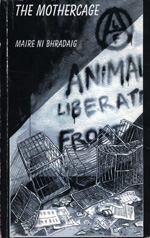
…

